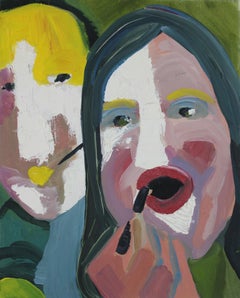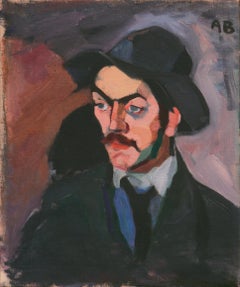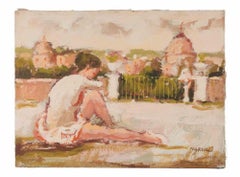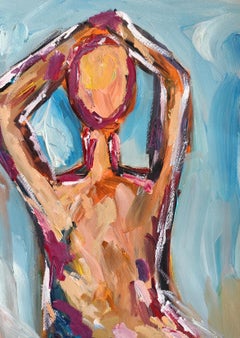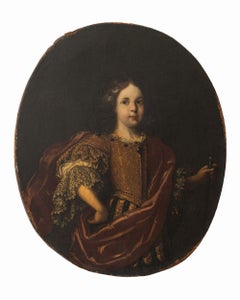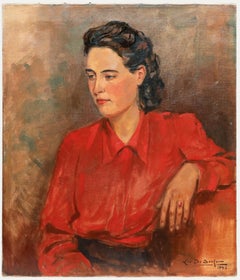Unframed Portrait Paintings
2010s Contemporary Portrait Paintings
Oil, Canvas
1920s Post-Impressionist Figurative Paintings
Canvas, Oil
1970s Contemporary Figurative Paintings
Oil
2010s Abstract Portrait Paintings
Paper, Acrylic
Mid-17th Century Baroque Portrait Paintings
Canvas, Oil
20th Century Portrait Paintings
Oil
2010s Contemporary Figurative Paintings
Mixed Media, Acrylic, Oil Pastel, Glitter, Spray Paint, Paper
2010s Impressionist Portrait Paintings
Canvas, Oil
2010s Contemporary Portrait Paintings
Canvas, Acrylic
21st Century and Contemporary Figurative Paintings
Canvas, Oil
2010s Contemporary Figurative Paintings
Oil, Canvas
21st Century and Contemporary Expressionist Figurative Paintings
Canvas, Acrylic
2010s Abstract Impressionist Abstract Paintings
Canvas, Oil
1940s Post-Impressionist Portrait Paintings
Pastel, Board
21st Century and Contemporary Neo-Expressionist Portrait Paintings
Canvas, Acrylic
1960s Surrealist Figurative Paintings
Oil, Panel
2010s Abstract Impressionist Portrait Paintings
Oil, Cardboard
21st Century and Contemporary Contemporary Portrait Paintings
Canvas, Charcoal, Acrylic
Mid-20th Century Modern Figurative Paintings
Canvas, Oil
21st Century and Contemporary Expressionist Figurative Paintings
Canvas, Acrylic, Oil
2010s Pop Art Portrait Paintings
Mixed Media, Pigment, Archival Pigment
21st Century and Contemporary Contemporary Figurative Paintings
Canvas, Acrylic
21st Century and Contemporary Expressionist Figurative Paintings
Acrylic, Canvas
Mid-20th Century Realist Portrait Paintings
Oil
20th Century Portrait Paintings
Acrylic
21st Century and Contemporary Contemporary Mixed Media
Paper, Charcoal, Acrylic
21st Century and Contemporary Minimalist Animal Paintings
Paper, Ink
21st Century and Contemporary Contemporary Figurative Paintings
Canvas, Acrylic
Mid-20th Century Abstract Portrait Paintings
Oil
Early 2000s Contemporary Figurative Paintings
Oil
21st Century and Contemporary Contemporary Portrait Paintings
Canvas, Acrylic, Pen
21st Century and Contemporary Contemporary Portrait Paintings
Canvas, Acrylic
2010s Realist Portrait Paintings
Canvas, Oil
2010s Pop Art Portrait Paintings
Canvas, Mixed Media, Spray Paint, Acrylic
21st Century and Contemporary Abstract Abstract Paintings
Oil
20th Century Realist Portrait Paintings
Canvas, Oil
21st Century and Contemporary Contemporary Figurative Paintings
Canvas, Oil
2010s Street Art Portrait Paintings
Mixed Media, Pigment, Archival Pigment
Mid-20th Century Modern Portrait Paintings
Oil, Canvas
2010s Neo-Expressionist Portrait Paintings
Acrylic, Permanent Marker
Late 20th Century Contemporary Figurative Paintings
Canvas, Acrylic
Artist Comments
An elderly couple walks arm in arm along a misty street, their quiet closeness framed by golden autumn leaves. The fog softens the outlines of buildings and lam...
21st Century and Contemporary Contemporary Figurative Paintings
Oil
21st Century and Contemporary Contemporary Portrait Paintings
Canvas, Mixed Media, Oil, Acrylic
2010s Folk Art Figurative Paintings
Acrylic, Canvas
21st Century and Contemporary Contemporary Figurative Drawings and Water...
Paper, Ink, Watercolor, Gouache
21st Century and Contemporary Contemporary Figurative Paintings
Canvas, Acrylic
Mid-20th Century Post-Impressionist Portrait Paintings
Oil
2010s Modern Portrait Paintings
Canvas, Acrylic
2010s Pop Art Portrait Paintings
Permanent Marker
Mid-20th Century Impressionist Portrait Paintings
Oil
21st Century and Contemporary Contemporary Portrait Paintings
Gold Leaf
21st Century and Contemporary Pop Art Portrait Paintings
Latex, Oil, Panel
21st Century and Contemporary Contemporary Portrait Paintings
Canvas, Acrylic
Late 20th Century Modern Portrait Paintings
Oil
Artist Comments
A figure, cloaked in teal, calmly extends an apple forward against a muted rose background. The fruit, glowing with realism and crowned with a leaf, contrasts w...
21st Century and Contemporary Contemporary Figurative Paintings
Oil
2010s Impressionist Portrait Paintings
Canvas, Oil
2010s Pop Art Portrait Paintings
Canvas, Mixed Media, Spray Paint, Acrylic
21st Century and Contemporary Contemporary Portrait Paintings
Canvas, Acrylic
21st Century and Contemporary Contemporary Figurative Paintings
Canvas, Acrylic
21st Century and Contemporary Contemporary Mixed Media
Canvas, Charcoal, Oil, Acrylic
Read More
Cecilia Vicuña Merges Politics, Science and Spirituality in Her Poetic Art
The Chilean creator, who has been living in exile in New York for decades, is having a major moment, receiving the biggest exhibitions, commissions and awards an artist could dream of.
In Christopher Spitzmiller’s New York Homes, His Love of Dogs Is on Full Display
The ceramist, designer and gentleman farmer tells us about the collection of antique dog art he has spread across a New York City apartment and a Greek Revival farmhouse in the Hudson Valley.
This Wiener Werkstätte Master Made Everything into Art
Koloman Moser smashed the conservative conventions of art and design in fin-de-siècle Vienna. On the 100th anniversary of his death, the Austrian designer is being celebrated for his radically modern creations.
